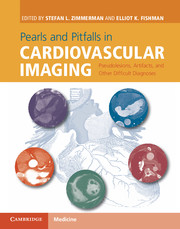 Pearls and Pitfalls in Cardiovascular Imaging
Pearls and Pitfalls in Cardiovascular Imaging from Section 11 - Veins
Published online by Cambridge University Press: 05 June 2015
Imaging description
Obstruction of the superior vena cava (SVC) may lead to the formation of portosystemic venous shunting leading to increased blood flow in the quadrate lobe (segment IV) of the liver as seen on contrast-enhanced CT (CECT) and also classically seen as the “hotquadrate lobe” sign on 99mTc–sulfur colloid scans of the liver. Collateral flow from the subclavian vein goes to the superior epigastric vein via the internal mammary vein into the recanalized paraumbilical vein, which in turn drains into the left portal vein creating a characteristic wedge-shaped area of enhancement in the quadrate lobe during the arterial phase of the CT (Figures 94.1–94.5). Blood is shunted to the IVC via the hepatic veins ultimately reaching the right atrium. The internal mammary vein also drains into inferior phrenic vein and subcapsular hepatic veins, which in turn drain into the intrahepatic portal tributaries. This pathway causes subdiaphragmatic focal enhancement near the bare area of the liver (Figures 94.4, 94.5, and 94.6). Additionally, the azygos and the hemiazygos veins may also become dilated and tortuous as a result of diversion of blood from the superior to the inferior vena cava (Figure 94.6).
Other collateral pathways for SVC obstruction include the lateral thoracic and superficial thoracoabdominal venous route, and the vertebral venous plexus route.
Importance
Causes of obstruction of the SVC include compression by a mediastinal neoplasm, post-radiation fibrosis, mediastinitis, or thrombosis and stenosis due to presence of indwelling catheters. Cavoportal collaterals due to SVC obstruction may be seen as a hypervascular lesion on a contrast-enhanced CT and can be mistaken for a tumor. This could expose the patient to risks of unnecessary imaging and/or invasive testing such as a biopsy. Presence of collateral vessels seen on CT is a highly accurate predictor of SVC obstruction with a sensitivity of 96% and a specificity of 92%.
Typical clinical scenario
SVC obstruction may be seen in patients with mediastinal masses, post-radiation fibrosis, or long-term indwelling catheters. A typical CT would show absence of contrast in the superior vena cava distal to the site of obstruction with luminal thrombus or stenosis, combined with enhancement of the collateral vessels.
To save this book to your Kindle, first ensure [email protected] is added to your Approved Personal Document E-mail List under your Personal Document Settings on the Manage Your Content and Devices page of your Amazon account. Then enter the ‘name’ part of your Kindle email address below. Find out more about saving to your Kindle.
Note you can select to save to either the @free.kindle.com or @kindle.com variations. ‘@free.kindle.com’ emails are free but can only be saved to your device when it is connected to wi-fi. ‘@kindle.com’ emails can be delivered even when you are not connected to wi-fi, but note that service fees apply.
Find out more about the Kindle Personal Document Service.
To save content items to your account, please confirm that you agree to abide by our usage policies. If this is the first time you use this feature, you will be asked to authorise Cambridge Core to connect with your account. Find out more about saving content to Dropbox.
To save content items to your account, please confirm that you agree to abide by our usage policies. If this is the first time you use this feature, you will be asked to authorise Cambridge Core to connect with your account. Find out more about saving content to Google Drive.